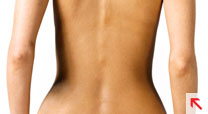Laser Hair Removal
Laser hair removal is one of the most popular cosmetic procedures performed. Unwanted hair grows on various regions of the body. Often, individuals find the presence of hair in certain regions of the body unsightly or embarrassing. In other instances, individuals wish to lessen the need for shaving, waxing, tweezing, or other methods of hair removal. Most commonly, laser hair removal is used to reduce hair growth on the face, back, legs, forearm, underarm, and bikini line. However, laser hair removal can be used to permanently reduce the amount of hair on any area of the body.
How Laser Hair Removal Works
During laser hair removal, a laser emits light energy that travels through the skin and is absorbed by the pigment in the hair follicle and hair shaft. Pigments are the substances that give skin and hair its color. The laser works by selective photothermolysis, which means that the light energy is selectively absorbed by pigmented areas. Hair follicles that are in the anagen, or active growth phase, have the largest amount of melanin, or pigment, and can absorb light energy from the laser. However, hair follicles that are in catagen or telogen growth phases are less pigmented. Therefore, these follicles do not absorb light energy as well and hair growth is not impaired. The energy, or heat, from the laser damages the hair follicle, which impairs its ability to grow hair. With time, the hairs that were present in the damaged follicles will fall out, resulting in a smoother appearance and less hair growth.
Ideal Candidates
It is important to realize that light energy will be absorbed by any type of pigment. For optimal results, your hair must be darker than your skin. This is why individuals with fair complexions and dark hair are better candidates for laser hair removal than individuals with darker complexions or lighter colored hair. If you have a darker complexion, the pigment in your skin will absorb some of the light energy emitted from the laser. As a result, the hair follicles may absorb less energy and your skin may be damaged by the laser. In these instances, your physician may choose to use a lower laser setting, which emits less energy. If you have lighter colored hair, your hair follicles have less pigment. Therefore, the follicles will not absorb energy from the laser as well as those with darker pigment. In both of these instances, it is likely that you will require more treatments to achieve the desired outcome. However, with new technology, laser hair removal may be used successfully on individuals of all skin and hair types.
Procedure Preparation
Prior to the start of your procedure, Dr. Feldman or his staff may choose to shave or trim the hair in the area. Often, Dr. Feldman will apply a cooling gel to the treatment area, which will help prevent heat produced by the laser from damaging your skin. In addition, Dr. Feldman will use a special cooling tip on the laser that applies a coolant during the procedure. The procedure is somewhat painful, and you may request a topical anesthetic if you are sensitive to pain. You will be given eyewear to protect your eyes from the intense light produced by the laser. The length of a laser hair removal procedure depends on the treatment area. A procedure in which hair is removed from a small region, such as the underarm, may take only minutes, while a larger area, such as the legs or back, may last approximately one hour.
Laser Hair Removal Procedure
During the procedure, Dr. Feldman will guide the laser over the treatment area. As the laser pulses intermittently, it delivers light energy, which travels through the skin and is absorbed by the hair follicles. Hair follicles in the anagen growth phase have more pigment than follicles in the other inactive phases of the growth cycle. Therefore, they are able to absorb the light energy delivered by the laser. Those hair follicles that absorb energy, or heat, from the laser will be damaged. Hairs that were present in the follicles at the time of treatment will fall out, and future hair growth will be impaired.
As not all hairs are actively growing at the same time, a single procedure will not treat all of the hair follicles in the area. As the follicles in the transitional and resting periods return to the active growth phase, you may notice some hair growth in the region. This is why multiple treatments are usually required to treat a single area completely.
Laser Hair Removal Recovery
Following the procedure, your skin may appear red or irritated. However, the redness will likely dissipate within one to two days. Dr. Feldman may recommend that you use a topical cream to protect your skin as it heals. It is also important to use sunscreen for a few weeks following the procedure. You should not use any products that may irritate your skin such as alpha hydroxy acids or harsh astringents. In addition, you should avoid plucking or waxing of the treatment area.
Laser Hair Removal Results
You may notice some hair that appears on the surface of your skin within seven to ten days following treatment. These hairs are usually those that have fallen out of hair follicles impaired during treatment. However, you will notice some new hair growth within a few weeks, as hair follicles that were inactive during treatment re-enter the active growth phase. Therefore, you will most likely undergo multiple treatments spaced approximately four weeks apart. Although the number of treatments varies by individual, most individuals receive approximately three to six treatments.
The results from a laser hair removal procedure depend on your skin tone, your hair type, and the growth phase of the hair being treated. It is important to realize that laser hair removal will likely not prevent hair from growing completely. However, laser hair removal can reduce hair growth significantly over time giving your skin the smooth appearance that you desire.
The Most Common Procedures We Perform:









